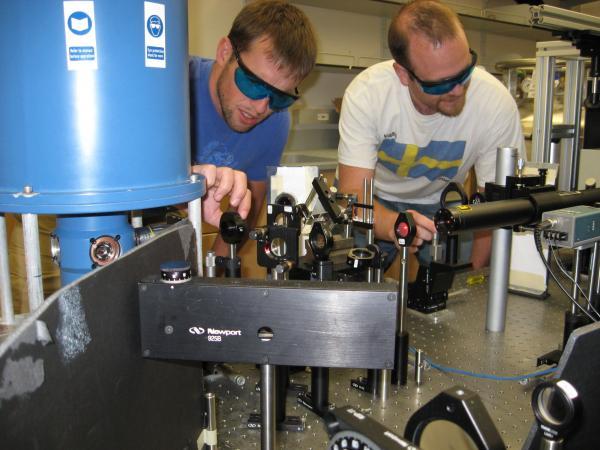New type of 'excitonic' computer a step closer to commercial viability

The physicists at UC San Diego that a year ago created the first integrated circuit using particles called excitons, now have discovered a technique that allows for operation at commercially cold temperatures.
This brings the possibility of a new type of extremely fast computer based on excitons closer to reality. When commercialized, the technology could speed computing and communications by better integrating electronic circuits and optical data communications.
Leonid Butov, a professor of physics at UCSD, is leading the research team that previously demonstrated an integrated circuit capable of working at 1.5 degrees Kelvin above absolute zero, or minus 457 degrees Fahrenheit. That temperature is less than the average temperature of deep space (-454.67 F), and achievable only in special research laboratories.
But now, the scientists report that they succeeded in building an integrated circuit that operates at 125 degrees Kelvin (minus 234 degrees Fahrenheit), a temperature that can be "easily" attained commercially with liquid nitrogen, a substance that costs about as much per liter as gasoline. The discovery is detailed in the latest online issue of the journal Nature Photonics,
Butov puts perspective on his team's finding: “Our goal is to create efficient devices based on excitons that are operational at room temperature and can replace electronic devices where a high interconnection speed is important. We’re still in an early stage of development. Our team has only recently demonstrated the proof of principle for a transistor based on excitons and research is in progress.”
Let's take a look at how excitons work and their application to computing. These energized electrons bound to positively charged counterparts called holes, which form when light hits a semiconductor such as gallium arsenide. When the electron and hole recombine, the exciton decays and releases its energy as a flash of light. According to the IEEE, the fact that they can be converted into light makes devices that use them faster and more efficient than conventional electronic devices with optical interfaces.
"Optical devices use electrons for computation and must then convert them to light for use in communications devices. Excitons, however, directly interact with electric fields, eliminating the need for all the conversion steps and making for potentially faster and more energy-efficient computing."
But excitons are tricky to use, because they are extremely unstable, ordinarily living only for tens of picoseconds (1 trillionth of a second). Last year, Butov and his group were able to extend the life of the exciton to 100 nanoseconds (1 billionth of a second), which he said is, ”A lifetime long enough to perform all the necessary operations.”
"Our transistors process signals using excitons, which like electrons can be controlled with electrical voltages, but unlike electrons transform into photons at the output of the circuit,” Butov said. “This direct coupling of excitons to photons allows us to link computation and communication."
Noteworthy, the report does not make any numerical estimates of the kind of processing speed that we can expect with exciton-based computing and how it would compare to other emerging forms of computing, such as quantum. Perhaps the research is still too early for that.
Other members of the team involved in the discovery were physicists Gabriele Grosso, Joe Graves, Aaron Hammack and Alex High at UC San Diego (pictured above), and materials scientists Micah Hanson and Arthur Gossard at UC Santa Barbara.
(Sources: UC San Diego, IEEE)
